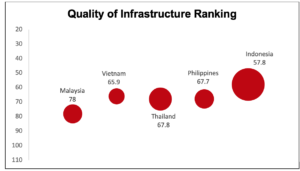Population – With 97 million people residing in the country and an annual population growth rate of 1%, Vietnam is one of the most densely-populated nations in Southeast Asia. It recorded a literacy rate of 96% in 2018, a significant increase from 87.6% in 1989. The country has also made tremendous advancements towards reducing poverty. As showcased in the figure below, the country’s poverty ratio fell from 20.7% to 6.7% in the last decade to position Vietnam ahead of Indonesia and Thailand.

The improvements in its healthcare system and population growth have helped boost its labor force to 57 million, the second largest in Southeast Asia. Further training initiatives will be necessary to ensure that these workers and jobseekers remain employable, and can contribute to the country’s economic growth.
Quality of Infrastructure Ranking – Vietnam has improved the quality of its infrastructure to rank #66 globally from #123 in [2008]. This indicates an upward trajectory for the country on the global development ladder and bodes well in its search for foreign investment.

Age – It has a large working age population as over two-thirds of its inhabitants are between the ages of 15 and 64. Unlike many of its peers in the region, Vietnam is not grappling with an ageing population and can leverage its young workforce to attract the attention of foreign investors.

Religious and ethnic diversity – Vietnam recognizes 54 ethnic groups. As depicted in the chart below, the Kinh form the nation’s largest ethnic group, constituting 85.3% of the country’s population as of 2019. Most of its population is culturally Buddhist, although

Vietnam does not have an official state religion. Most of its population identifies as having no religion (86.3%) and many are culturally Buddhist and/or follow folk traditions. Besides this, the other main religions in Vietnam are Buddhism, Taoism, Confucianism and Christianity.

Stay up to update with our latest news.
Have Us Contact You
